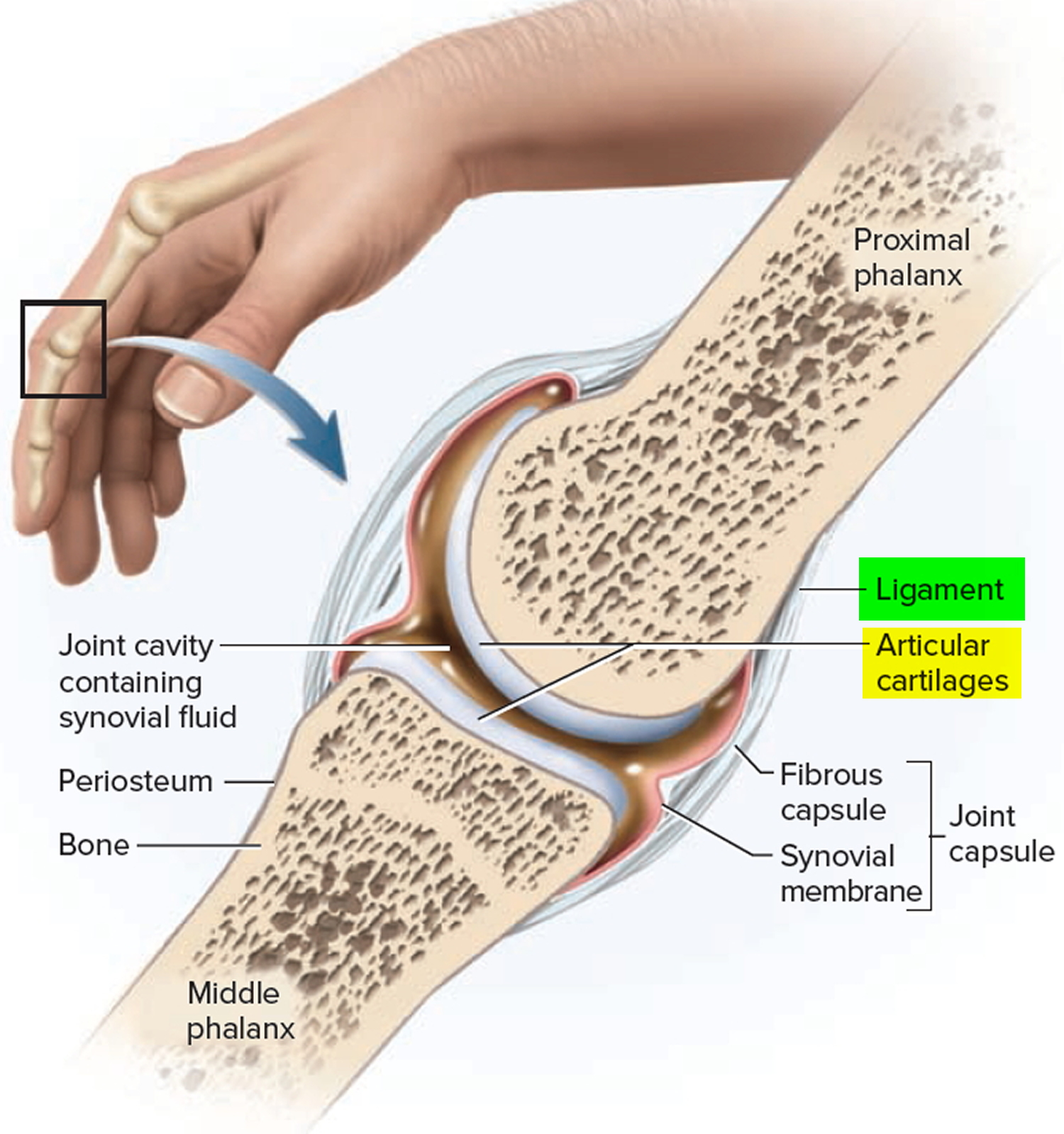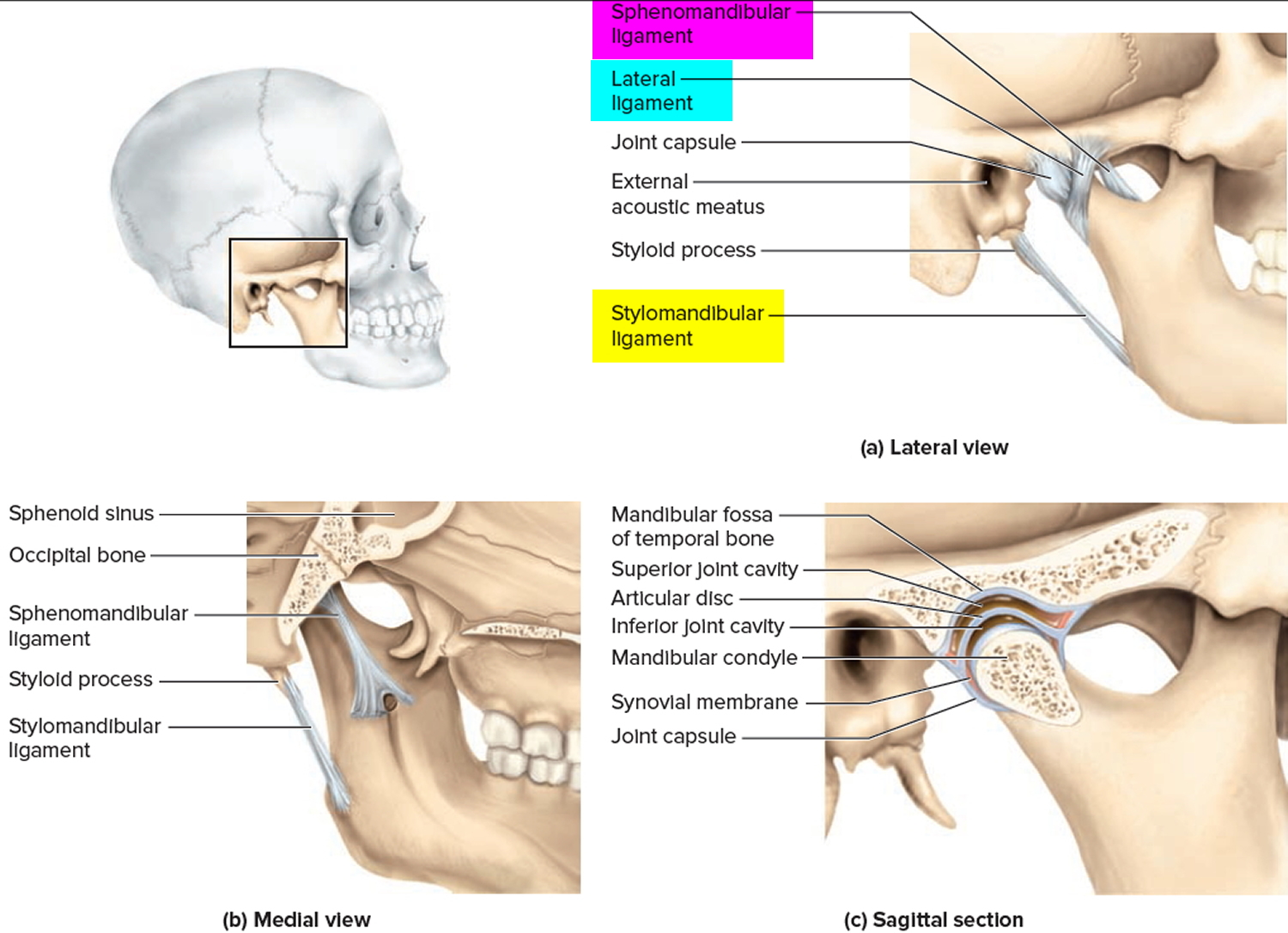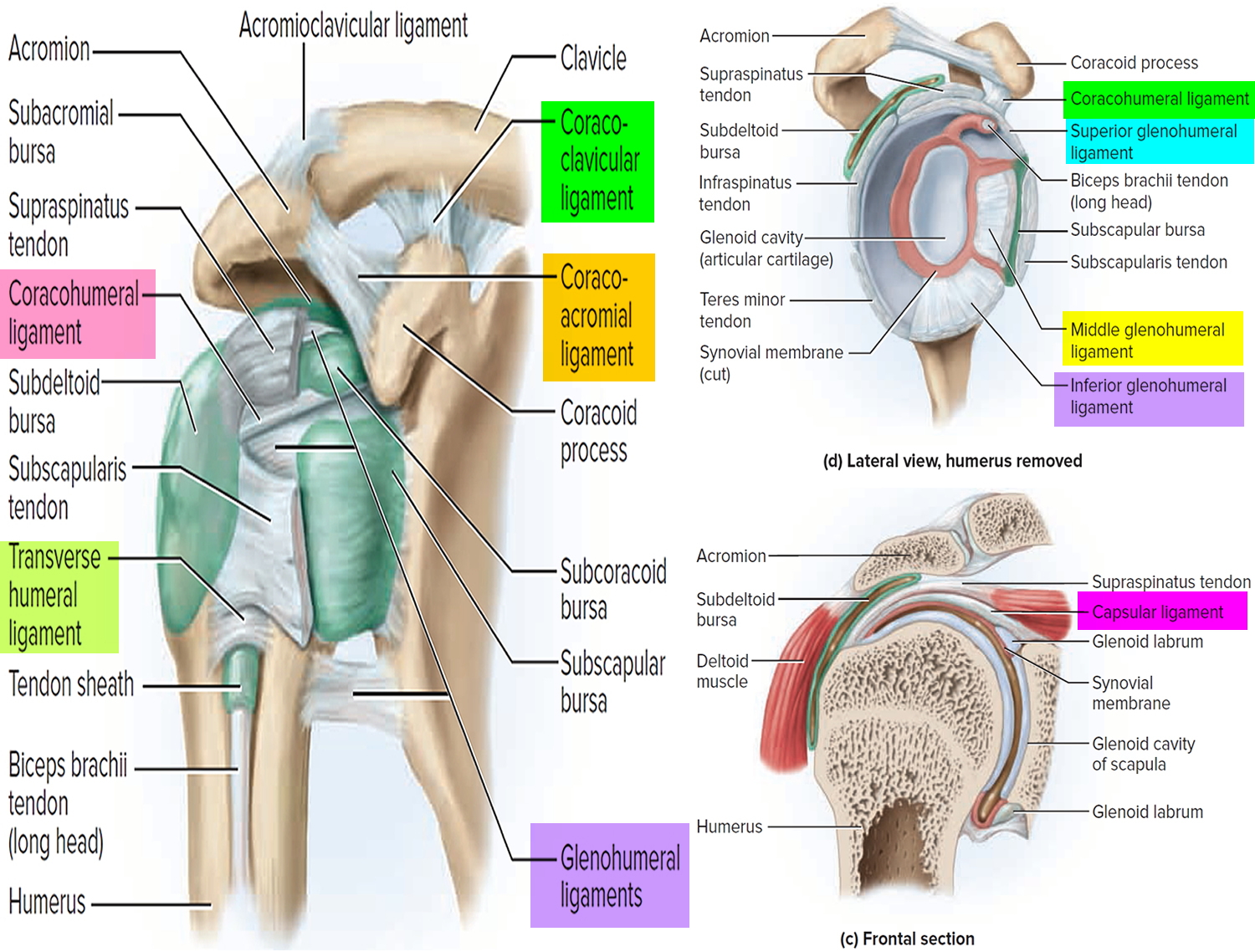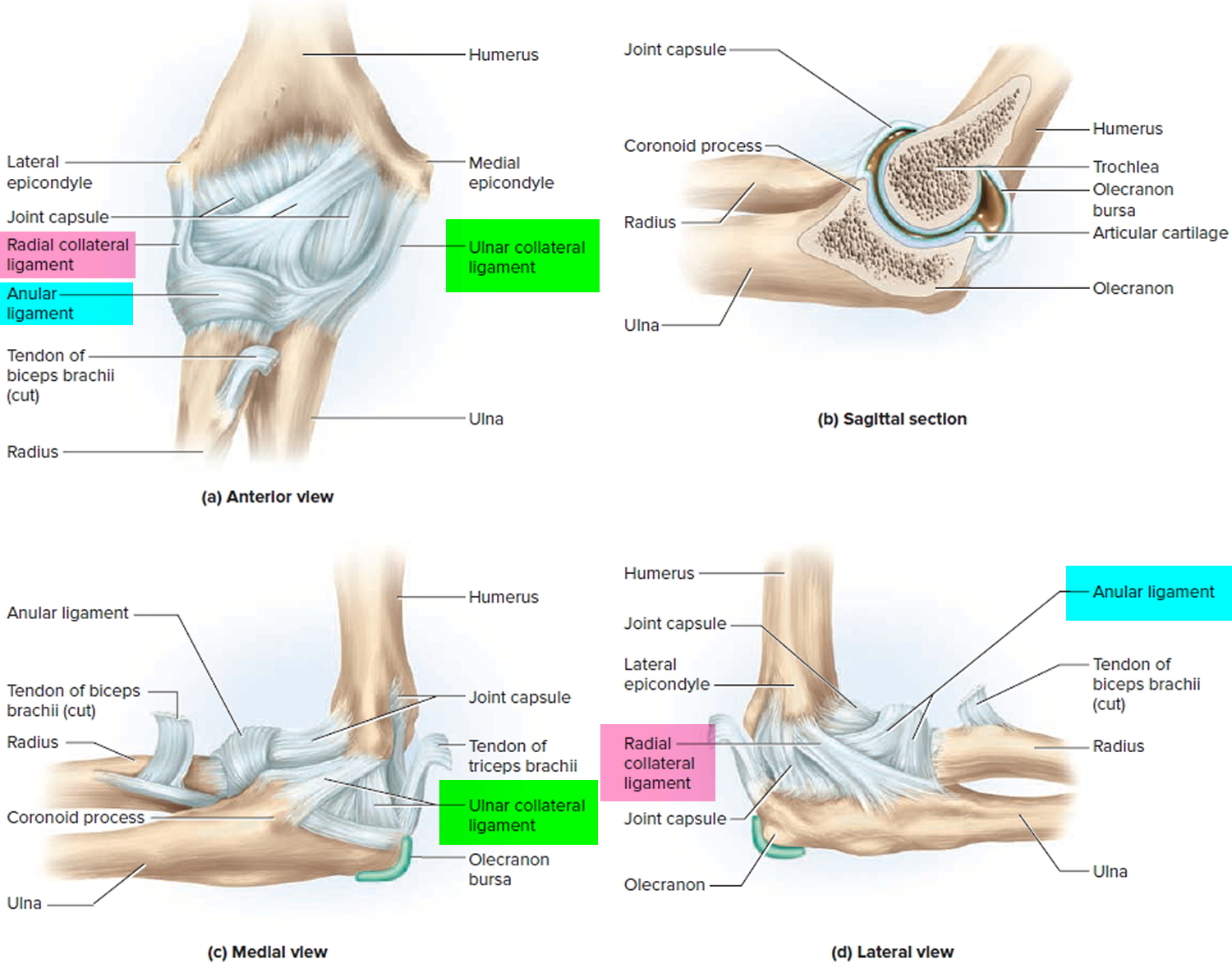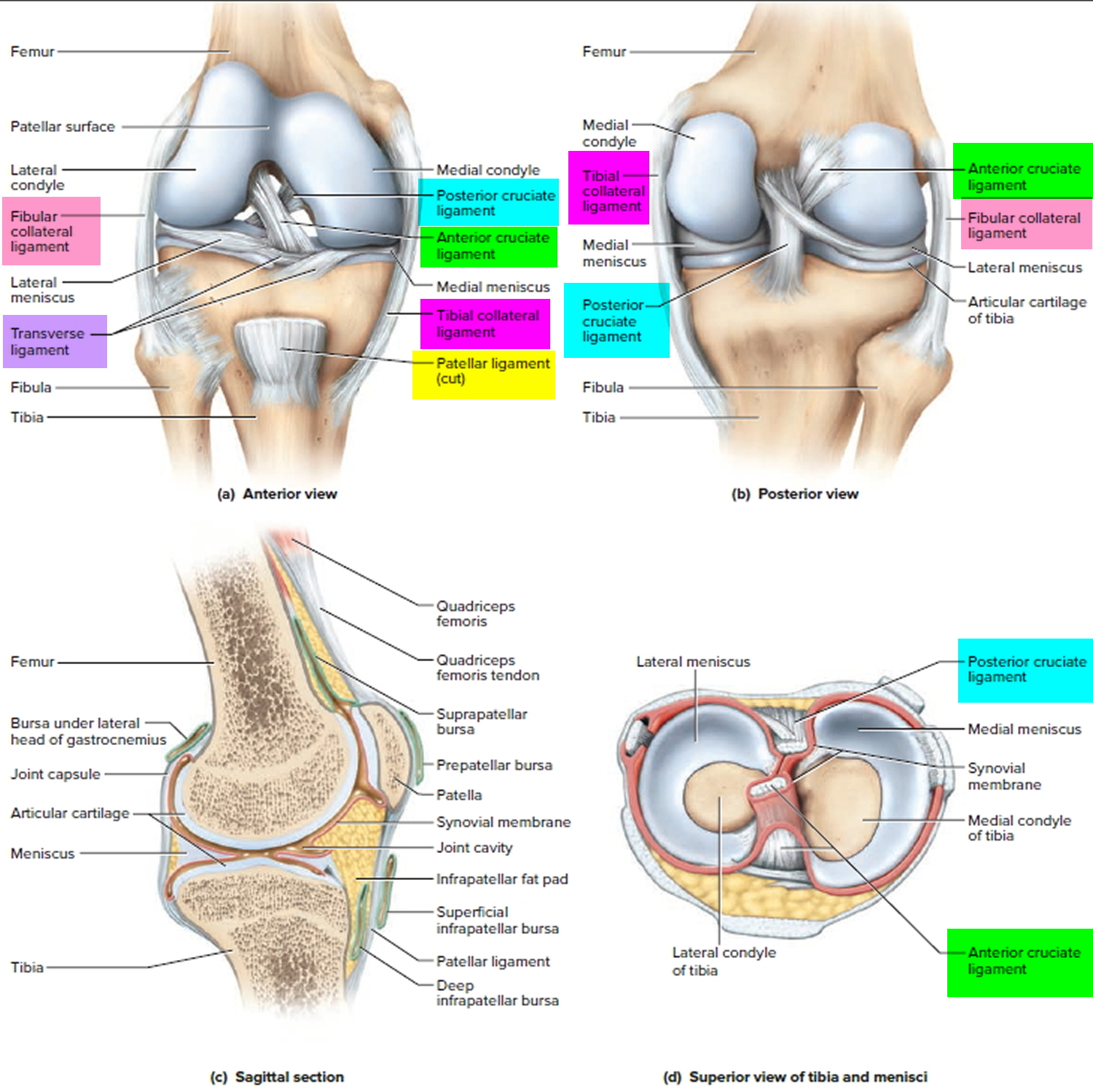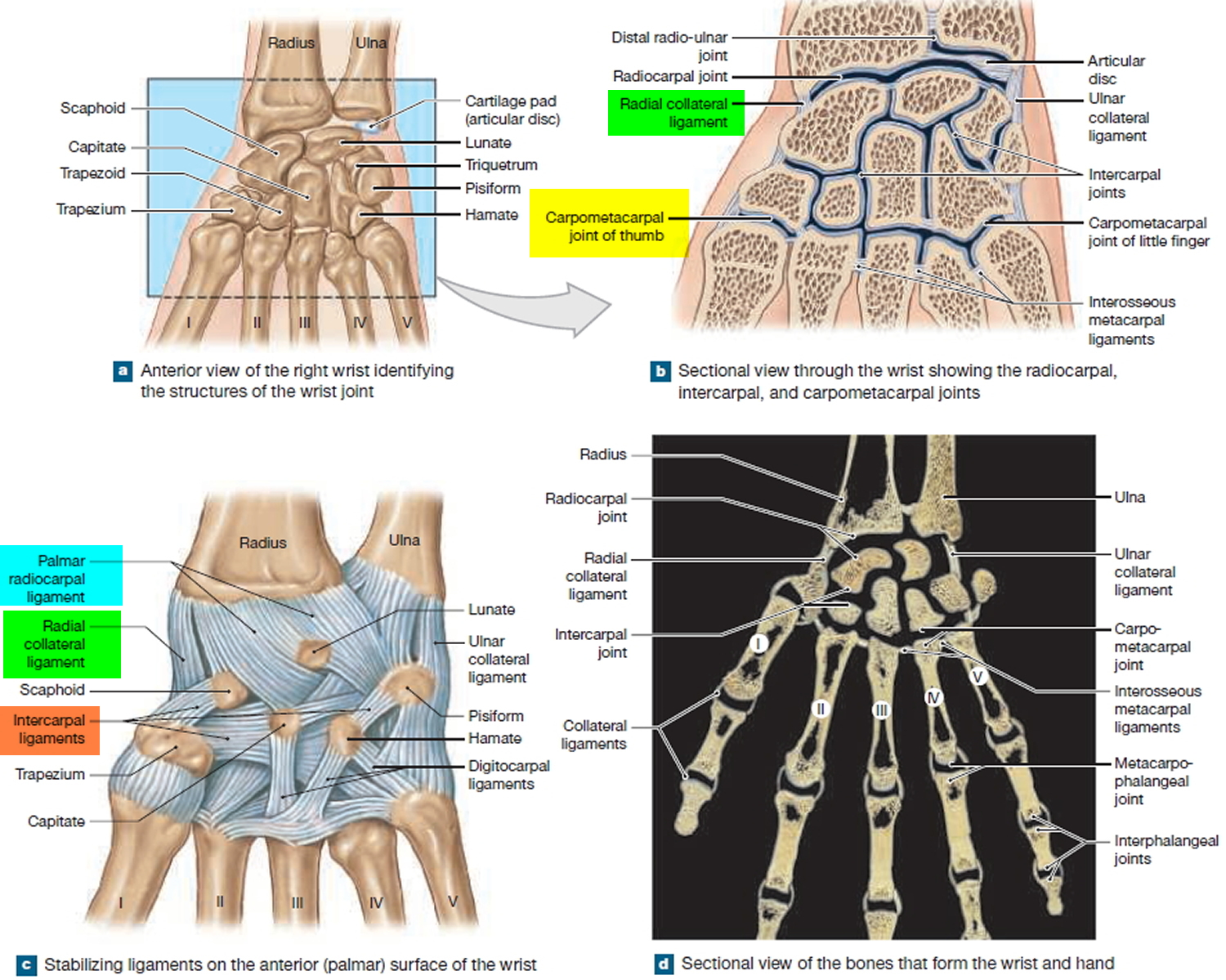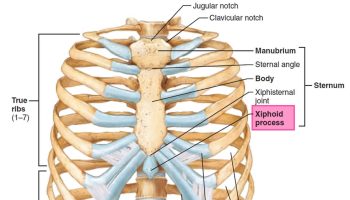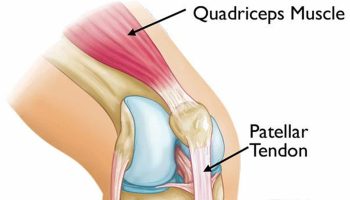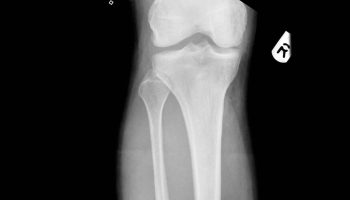Contents
What are ligaments
Ligaments are connective tissues that connect bones to other bones and tightly bind bones together and resist stress.
Tendons are structurally similar to ligaments but attach muscles to bones and and transfer muscular tension to bones.
Both tendons and ligaments are dense regular connective tissue, because of its two properties: (1) The collagen fibers are closely packed (dense) and leave relatively little open space, and (2) the fibers are parallel to each other (regular). The parallel arrangement of fibers is an adaptation to the fact that musculoskeletal stresses pull tendons and ligaments in predictable directions. With minor exceptions such as blood vessels and sensory nerve fibers, the only cells in this tissue are fibroblasts, visible by their slender, violet-staining nuclei squeezed between bundles of collagen. This type of tissue has few blood vessels, so injured tendons and ligaments are slow to heal.
The articulations of the phalanges (finger joints) are joined by ligaments that limit their movement (see Figure 1). As you flex one of your knuckles, ligaments on the anterior (palmar) side of the joint go slack, but ligaments on the posterior (dorsal) side tighten and prevent the joint from flexing beyond 90° or so. The knee is another case in point. In kicking a football, the knee rapidly extends to about 180°, but it can go no farther. Its motion is limited in part by a cruciate ligament and other knee ligaments described later. Gymnasts, dancers, and acrobats increase the range of motion of their synovial joints by gradually stretching their ligaments during training. “Double-jointed” people have unusually large range of motions at some joints, not because the joint is actually double or fundamentally different from normal in its anatomy, but because the ligaments are unusually long or slack.
Figure 1. Ligaments
Jaw joint ligaments
The temporomandibular (jaw) joint (TMJ) is the articulation of the condyle of the mandible with the mandibular fossa of the temporal bone.
Two ligaments support the joint. The lateral ligament prevents posterior displacement of the mandible. If the jaw receives a hard blow, this ligament normally prevents the condylar process from being driven upward and fracturing the base of the skull. The sphenomandibular ligament on the medial side of the joint extends from the sphenoid bone to the ramus of the mandible.
Figure 2. Temporomandibular (jaw) joint ligaments
Shoulder joint ligaments
The glenohumeral (humeroscapular) joint or shoulder joint, is where the hemispherical head of the humerus articulates with the glenoid cavity of the scapula.
The major ligaments that help stabilize the shoulder joint are shown in Figure 3.
- The capsule surrounding the shoulder joint is thin. Areas of localized thickening of the anterior capsule surface are known as the glenohumeral ligaments. These ligaments help stabilize the shoulder joint only when the humerus approaches or exceeds maximum normal motion.
- The coracohumeral ligament originates at the base of the coracoid process and inserts on the head of the humerus. This ligament strengthens the superior part of the articular capsule and supports the weight of the upper limb.
- The coraco-acromial ligament spans the gap between the coracoid process and the acromion, just superior to the capsule. This ligament provides additional support to the superior surface of the capsule.
- The strong acromioclavicular ligament attaches the acromion to the clavicle and restricts movement of the clavicle at the acromial end. A shoulder separation is a relatively common injury involving partial or complete dislocation of the acromioclavicular joint.
- The coracoclavicular ligaments attach the clavicle to the coracoid process and limit motion between the clavicle and scapula.
- The transverse humeral ligament extends between the greater and lesser tubercles and holds the tendon of the long head of the biceps brachii in the intertubercular groove of the humerus.
Figure 3. Shoulder joint ligaments
The Elbow Joint ligaments
The elbow is a hinge joint composed of two articulations: the humeroulnar joint where the trochlea of the humerus joins the trochlear notch of the ulna, and the humeroradial joint where the capitulum of the humerus meets the head of the radius. Both are enclosed in a single joint capsule. Side-to-side motions of the elbow joint are restricted by a pair of ligaments: the radial (lateral) collateral ligament and ulnar (medial) collateral ligament.
Another joint occurs in the elbow region, the proximal radioulnar joint, but it is not involved in the hinge. At this joint, the edge of the disclike head of the radius fits into the radial notch of the ulna. It is held in place by the anular ligament, which encircles the radial head and is attached at each end to the ulna. The radial head rotates like a wheel against the ulna as the forearm is pronated or supinated.
Figure 4. Elbow joint ligaments
The Hip Joint ligaments
The hip joint is the point where the head of the femur inserts into the acetabulum of the hip bone. Because the hip joints bear much of the body’s weight, they have deep sockets and are much more stable than the shoulder joint.
Ligaments that support the hip joint include the iliofemoral and pubofemoral ligaments on the anterior side and the ischiofemoral ligament on the posterior side. The name of each ligament refers to the bones to which it attaches—the femur and the ilium, pubis, or ischium. When you stand up, these ligaments become twisted and pull the head of the femur tightly into the acetabulum. The head of the femur has a conspicuous pit called the fovea capitis.
The round ligament or ligamentum teres, arises here and attaches to the lower margin of the acetabulum. This is a relatively slack ligament, so it is doubtful that it plays a significant role in holding the femur in its socket. It does, however, contain an artery that supplies blood to the head of the femur. A transverse acetabular ligament bridges a gap in the inferior margin of the acetabular labrum.
Figure 5. Hip Joint ligaments
Knee joint ligaments
The knee (tibiofemoral) joint is the largest and most complex diarthrosis of the body. It is primarily a hinge joint, but when the knee is flexed it is also capable of slight rotation and lateral gliding. The patella and patellar ligament also articulate with the femur to form a gliding patellofemoral joint.
The joint cavity contains two C-shaped cartilages called the lateral and medial menisci (singular, meniscus) joined by a transverse ligament. The menisci absorb the shock of the body weight jostling up and down on the knee and prevent the femur from rocking from side to side on the tibia.
The posterior popliteal region of the knee is supported by a complex array of extracapsular ligaments external to the joint capsule and two intracapsular ligaments within it.
The extracapsular ligaments include two collateral ligaments that prevent the knee from rotating when the joint is extended—the fibular (lateral) collateral ligament and the tibial (medial) collateral ligament—and other ligaments.
The two intracapsular ligaments lie deep within the joint. The synovial membrane folds around them, however, so that they are excluded from the fluid-filled synovial cavity. These ligaments cross each other in the form of an X; hence, they are called the anterior cruciate ligament (ACL) and posterior cruciate ligament (PCL). These are named according to whether they attach to the anterior or posterior side of the tibia, not for their attachments to the femur. When the knee is extended, the ACL is pulled tight and prevents hyperextension. The PCL prevents the femur from sliding off the front of the tibia and prevents the tibia from being displaced backward. The ACL is one of the most common sites of knee injury.
An important aspect of human bipedalism is the ability to lock the knees and stand erect without tiring the extensor muscles of the leg. When the knee is extended to the fullest degree allowed by the ACL, the femur rotates medially on the tibia. This action locks the knee, and in this state, all the major knee ligaments are twisted and taut. To unlock the knee, the popliteus muscle rotates the femur laterally and untwists the ligaments.
Figure 6. Knee Joint ligaments
The Ankle Joint ligaments
The ankle (talocrural) joint includes two articulations—a medial joint between the tibia and talus and a lateral joint between the fibula and talus, both enclosed in one joint capsule. The malleoli of the tibia and fibula overhang the talus on each side like a cap and prevent most side-to-side motion. The ankle therefore has a more restricted range of motion than the wrist.
The ligaments of the ankle include (1) anterior and posterior tibiofibular ligaments, which bind the tibia to the fibula; (2) a multipart medial (deltoid) ligament, which binds the tibia to the foot on the medial side; and (3) a multipart lateral (collateral) ligament, which binds the fibula to the foot on the lateral side.
The calcaneal (Achilles) tendon extends from the calf muscles to the calcaneus. It plantarflexes the foot and limits dorsiflexion. Plantar flexion is limited by extensor tendons on the anterior side of the ankle and by the anterior part of the joint capsule.
Sprains (torn ligaments and tendons) are common at the ankle, especially when the foot is suddenly inverted or everted to excess. They are painful and usually accompanied by immediate swelling. They are best treated by immobilizing the joint and reducing swelling with an ice pack, but in extreme cases may require a cast or surgery.
Figure 7. Ankle joint ligaments
Thumb joint ligaments
The wrist j oint is formed between the radius and carpal bones of the hand and between an articular disc, distal to the ulna, and carpal bones.
The first metacarpal bone has a saddle joint at the wrist, the carpometacarpal joint of the thumb. The joint between the metacarpal of the thumb (metacarpal
I) and one of the carpal bones allows greater mobility than the limited sliding movement that occurs at the carpometacarpal joints of the fingers.
Distally, the heads of metacarpals II to V (i.e. , except that of the thumb) are interconnected by strong ligaments.
Lack of this ligamentous connection between the metacarpal bones of the thumb and index finger together with the biaxial saddle joint between the metacarpal bone of the thumb and the carpus provide the thumb with greater freedom of movement than the other digits of the hand.
Figure 8. Thumb joint ligaments
